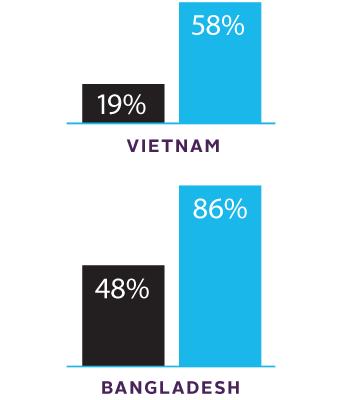Scaling up an infant and young child nutrition package that promotes exclusive breastfeeding for the first six months of life and optimal complementary feeding, in countries where most of the malnourished children reside, could save the lives of hundreds of thousands of infants every year.
In Bangladesh, Ethiopia and Vietnam, Alive & Thrive has demonstrated that scaling up effective infant and young child feeding programs quickly is possible. In just five years, the program rapidly shaped demand for, and overcame barriers to, better feeding practices among children under two years of age using an innovative combination of four proven interventions: advocacy to ignite change among policymakers; interpersonal communication and community mobilization to support mothers, families and communities; mass communication to reach more people and different audiences through creative and engaging messages; and the strategic use of data to make programmatic adjustments and maximize impact.
Alive & Thrive applies all four components in each country and adapts them to fit individual country needs and contexts. In Vietnam, for example, advocacy efforts led to national policies to extend paid maternity leave to six months for all salaried female employees and to expand restrictions on the marketing of breastmilk substitutes for children up to 24 months of age. With local partners, we established more than 1,100 social franchises in government health facilities and created 700 support groups for infant and young child feeding practices in remote areas, where access to health facilities is limited. From January 2012 to March 2014, the program’s interpersonal communication component (counseling at health facilities and support groups) reached about 460,000 mothers of children under two years of age. An estimated 2 million women saw the award-winning media campaign’s popular “Talking Babies” TV spots. Vietnam’s National Institute of Nutrition now routinely collects indicators on young child feeding practices in its annual National Nutrition Surveillance.
In each country, locally tailored campaigns, messages and interventions shift social norms and support women to breastfeed in a way that appeals to local beliefs and circumstances. The result: higher rates of exclusive breastfeeding and improved complementary feeding practices in all three countries and a new generation of children with a better chance of reaching their full potential for growth and development.

Increase in exclusive breastfeeding
